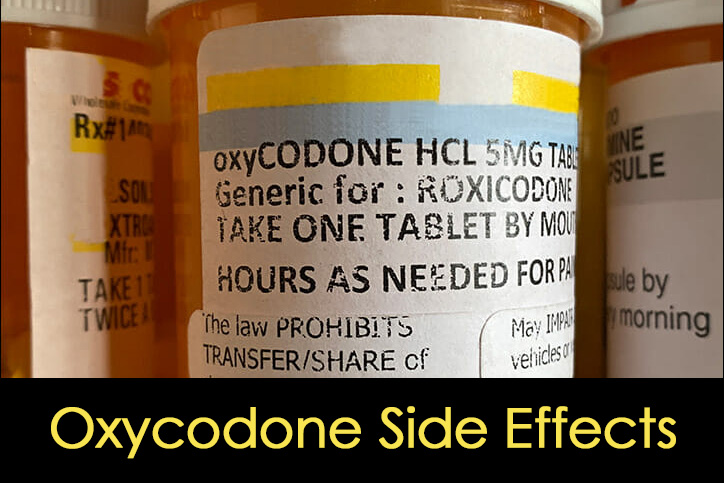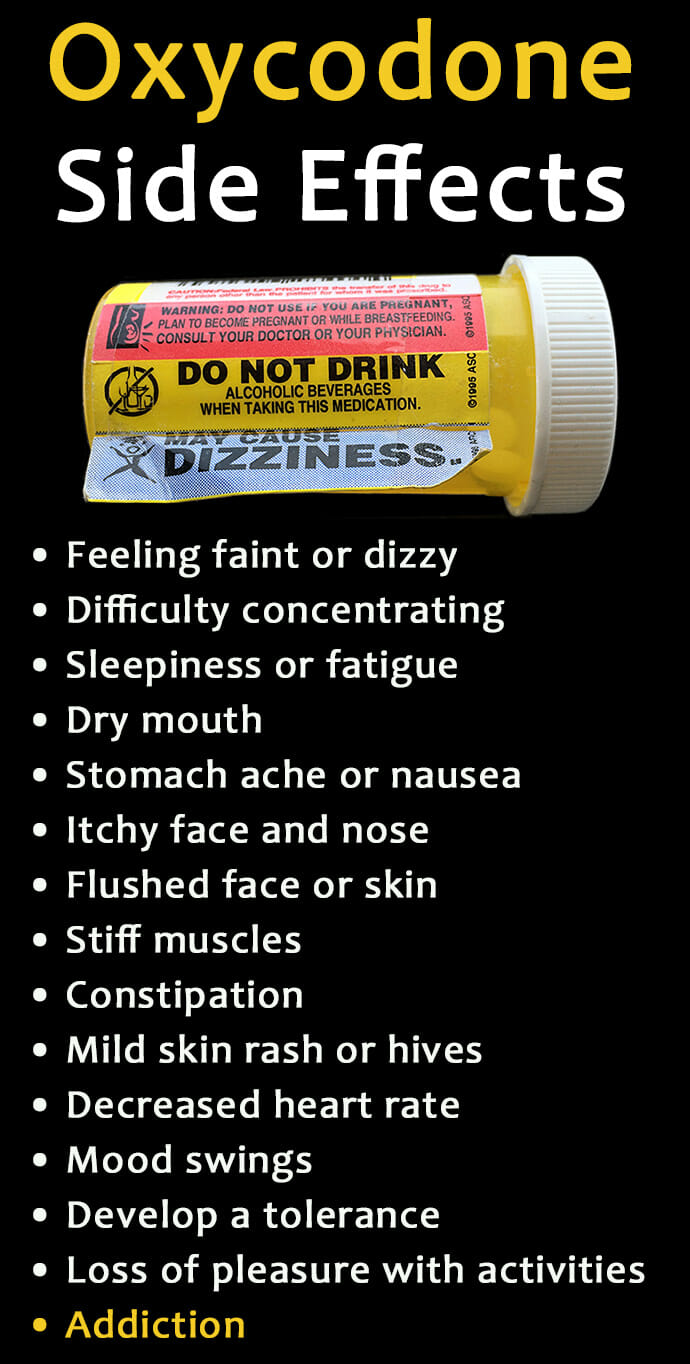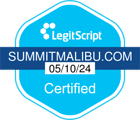Table of Contents
Like with many prescription medications, oxycodone side effects and withdrawal symptoms will vary depending on the dosage and length of use.
Opioids like oxycodone can be especially problematic because of the euphoric way they make the user feel and the potential for addiction.
Opioids are a class of highly addictive narcotic drugs that interact with opioid receptors in the brain. This includes naturally occurring or synthetic drugs related to or derived from the opium poppy plant.
Because they are powerful prescription painkillers, it’s important to identify any oxycodone side effects and understand how the drug’s use can progress through the 5 stages of addiction.
What is Oxycodone?
Oxycodone is an opioid prescription painkiller that interferes with pain signals sent by the body’s central nervous system.
Common brand names for oxycodone include OxyContin, Percodan, Percocet, and Roxicodone.
Painkillers like oxycodone bind to opioid receptors in the spinal cord, brain stem, and an area of the brain associated with pleasure.
They essentially mimic the body’s natural ability to block pain. The drug tricks the brain into thinking there is less pain than the body is actually dealing with.
Oxycodone is generally prescribed for moderate to severe pain caused by injury or post-surgery related pain during the recovery period.
In some cases, the opioid painkiller oxycodone is prescribed for chronic pain related to illnesses like cancer, or for lingering pain due to a traumatic injury that has caused permanent damage to the body.
This prescription painkiller comes in different doses and forms like capsules, tablets, liquid, and suppositories. It should only be used for a short time because it is highly addictive and can be lethal when misused or abused.
According to the Centers for Disease Control and Prevention, an estimated 79,358 drug overdose deaths in 2023 involved an opioid, like oxycodone.
Oxycodone vs. Hydrocodone
Oxycodone and hydrocodone are both proven and powerful narcotic painkillers that are only available with a prescription.
The two drugs also behave in the same way, by blocking or dampening pain signals sent by the central nervous system.
Each of these painkillers is often combined with other painkilling medications, such as acetaminophen.
The pure form of oxycodone is sold under the brand name Oxycontin, a tablet taken orally, usually every 12 hours.
Zohydro ER is the brand name drug for pure hydrocodone, also taken by mouth every 12 hours.
When comparing the strength of hydrocodone Zohydro vs oxycodone, they are equally effective for reducing pain, although oxycodone has a higher potency and requires a lower dose for the same relief.
Oxycodone and hydrocodone are both classified as schedule II drugs by the Drug Enforcement Administration. This means that they have a high potential for being misused and abused.
How Long Does Oxycodone Stay in Your System?
An effective pain relief dosage of oxycodone will vary from person to person. Physicians typically start patients on smaller doses and increase them until pain is under control.
At the proper dosage, oxycodone starts to take effect within 20 to 30 minutes after taken orally.
Oxycodone reaches its peak blood concentration around the one-to-two-hour mark, though extended-release formulas generally take three to four hours to reach peak concentration in the bloodstream.
For most people, oxycodone fully metabolizes and clears the blood in a 24-hour period, though it is still traceable in urine, saliva, and hair for longer.
Even taken as prescribed, most people will quickly build a tolerance to oxycodone, meaning it may take longer to feel the drug’s effects. This means the prescribed dosage won’t seem as effective in treating pain as it did previously.
Opioid tolerance is one reason drugs like oxycodone can be so habit forming. People will often misuse the medication by taking more than prescribed to get the amount of pain relief they originally felt.
Painkillers like oxycodone become a problem when a person develops an opioid dependence and doctors stop prescribing them. This leads many people to find any way possible to get more of the drug.
Opioids such as oxycodone and hydrocodone purchased illegally can be expensive, so people turn to cheaper, more powerful opioids that lead to addiction.
Heroin and fentanyl addiction are fueling the opioid epidemic and many of the overdose deaths are caused by these powerful opioids.
Oxycodone Side Effects
Even though opioids are effective for relieving pain, the side effects of oxycodone and similar painkillers can be extremely uncomfortable and even dangerous.
Common oxycodone side effects include:
- Feeling faint or dizzy
- Difficulty focusing, concentrating, or feeling restless
- Sleepiness, exhaustion, or fatigue
- Dry mouth
- Stomach ache or nausea
- Itchy face and nose
- Sweating and flushed face or skin
- Stiff muscles
- Constipation, as well as difficulty urinating
- Mild skin rash or hives
- Decreased heart rate
- Mood swings, from euphoria to anger or depression
The side effects of oxycodone when taken for longer than the prescribed period or misusing the drug can be much more serious.
This can lead to addiction, a potentially fatal overdose, or painful withdrawal symptoms that keep people in a cycle of abuse, if left untreated.
Withdrawal from opioids isn’t as dangerous as benzo withdrawal, but they can be just as difficult to quit when a person becomes addicted to them.
More Serious Oxycodone Side Effects
Most side effects of oxycodone are mild or manageable when taken as prescribed for a short time. Prolonged or excessive misuse can lead to complications like withdrawal or overdose.
Serious Oxycodone Side Effects
- Extreme drowsiness
- Labored or shallow breathing
- Chest pain or irregular heartbeat
- Severe mood changes
- Allergic reaction to the mouth, throat, or skin
- Seizures
- Confusion or hallucinations
- Muscle twitching or stiffness
Long-term Oxycodone Side Effects
- High tolerance that requires more of the drug to feel the original effects
- Mood disturbances, such as depression or anxiety
- Reduced libido
- Dental problems
- Social withdrawal
- Serious respiratory issues
- Chronic constipation or nausea
- Increased pain sensitivity
- Depression
- Risk of heart failure
- Loss of pleasure in people, places, and activities once enjoyed
- Problems at work, school, or relationships with friends or family
- Dependence and addiction
Withdrawal Symptoms of Oxycodone
- Flu-like symptoms
- Nausea, vomiting, and diarrhea
- Sweating, chills, and hot and cold flashes
- Difficulty sleeping
- Anxiety, agitation, and panic attacks
- Cravings for oxycodone
- Dilated pupils
- Fatigue and weakness
- Mood disturbances
- Runny nose and watering eyes
- Muscle and joint pain, along with spasms and tremors
- Loss of appetite
- Increased blood pressure and heart rate
- Uncontrollable yawning and restless leg kicking movements
PAWS symptoms from post-acute withdrawal syndrome can last for weeks or months after the acute symptoms subside.
Opioid Overdose Signs
- Slow or irregular heartbeat
- Difficulty breathing
- Chest pain and discomfort
- Extremely small pupils
- Pale or blue lips, skin, or fingernails
- Unresponsiveness or lack of awareness of surroundings
- Loss of consciousness or unable to wake up
Combining opioids with other drugs, such as alcohol, can create more dangerous side effects because both substances are central nervous depressants. This may lead to respiratory problems or be fatal in some cases.
Oxycodone Addiction Treatment
Even though a person going through oxycodone withdrawal might feel very sick or like they are going to die, the truth is that opioid withdrawal is not typically fatal. However, can be incredibly painful and uncomfortable.
Withdrawal symptoms from oxycontin can be so extreme that many people continue using the drugs instead of quitting to avoid feeling sick.
Anyone wanting to recover from oxycodone addiction should seek professional help at a medically supervised inpatient detox treatment facility for opioid withdrawal.
In some cases, Medication Assisted Treatment can help ease the symptoms of withdrawal from oxycodone as the drug works its way out of a person’s system.
After detox has been completed, a person addicted to oxycodone or other opioids will start a recovery treatment program.
Addiction treatment after detox usually begins with an assessment and one-on-one counseling to determine each person’s unique needs. and develop a strategic plan for lasting recovery.
Oxycodone addiction treatment often includes:
- Detox
- Individual Therapy
- Group Therapy
- Medication Assisted Treatment (MAT)
- Cognitive Behavioral Therapy
- Dialectical Behavior Therapy
- Family Counseling
- Relapse Prevention Therapy
While these are some of the most effective evidence-based rehab therapies, there are many other holistic methods that also work well to heal the mind, body, and soul for a lasting recovery.
Many cognitive therapy techniques are beneficial for recovery to address thoughts, emotions, and addictive behaviors.
Although there are many oxycodone side effects that can cause problems, the most complicated is the possibility of developing an addiction from misuse or abuse.
It’s important to speak with a doctor or treatment professional at the first signs of opioid dependence or addiction before it becomes too late.
Oxycodone Side Effects FAQs
What are the most common mild oxycodone side effects?
- Feeling sleepy or drowsy
- Dizzy or lightheaded
- Constipation
- Nausea or vomiting
- Dry mouth
- Sweating or a warm feeling
What are the most dangerous oxycodone side effects?
The most dangerous side effect of oxycodone, or any type of opioid, is unconsciousness and overdose. Aside from that, other dangerous side effects include:
- Severe breathing or respiratory problems
- Intense allergic reactions like swelling of the tongue and throat that make it difficult to swallow or breathe
- Chest pain and rapid heartbeat
- Oxygen deprivation that causes blue or pale lips and fingernails
- Hallucinations and confusion
If these side effects continue for more than a short time, immediately stop taking the medication and seek medical treatment.
How long do the side effects of oxycodone continue after you stop taking it?
The duration of oxycodone side effects after an individual stops taking it may depend on the type of symptom, dosage, and length of time taking the medication.
For short term use, most side effects will subside within a few days to a week. Long-term users may notice some symptoms that occur up to a few weeks.
The side effects from withdrawal symptoms can be much more severe and may require medical detox to remain comfortable.
Acute withdrawal symptoms usually last for a week to 10 days, while post-acute withdrawal side effects can remain for a longer period.
Is muscle loss a side effect of oxycodone?
Muscle loss is generally not a side effect of oxycodone use although muscle pain, stiffness, cramps, twitching, and tremors are common symptoms from chronic or long-term use.
Are oxycodone side effects the same as heroin or fentanyl?
Heroin, fentanyl, and oxycodone are all opioids, so they share many side effects and symptoms from use and abuse, such as nausea, constipation, drowsiness, and many others.
All three can cause a dependence, addiction, and withdrawal symptoms.
However, heroin and fentanyl are much more potent than oxycodone so the effects will be more intense. The onset of effects will also be much quicker, and the duration will be shorter than oxycodone.
The risk of overdose is also much greater for heroin and fentanyl than oxycodone.





